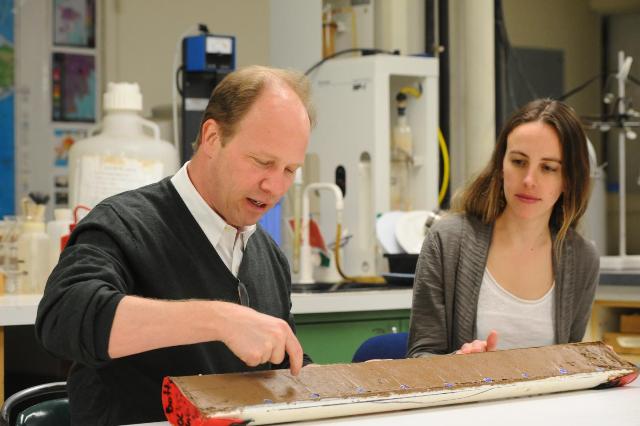Oct 12 2015
The Horn of Africa has become increasingly arid in sync with the global and regional warming of the last century and at a rate unprecedented in the last 2,000 years, according to new research led by a University of Arizona geoscientist.
 Researchers Peter deMenocal and Jessica Tierney examine a sediment core at Columbia University's Lamont-Doherty Earth Observatory. Scientists can use such cores of marine sediments to figure out what the climate was thousands of years ago. Credit:Credit: Lamont-Doherty Earth Observatory
Researchers Peter deMenocal and Jessica Tierney examine a sediment core at Columbia University's Lamont-Doherty Earth Observatory. Scientists can use such cores of marine sediments to figure out what the climate was thousands of years ago. Credit:Credit: Lamont-Doherty Earth Observatory
The region has suffered deadly droughts every few years in recent decades.
The scientists suggest as global and regional warming continues, the eastern Horn of Africa, which includes Somalia, Djibouti and Ethiopia, will receive progressively less rain during the crucial "long rains" season of March, April and May.
Such a trend could exacerbate tensions in one of the most geopolitically unstable regions in the world.
The team's suggestion that the Horn of Africa will become even drier contradicts the global climate models that indicate future warming will bring more rain to the region.
"What we see in the paleoclimate record from the last 2,000 years is evidence that the Horn of Africa is drier when there are warm conditions on Earth, and wetter when it is colder," said lead author Jessica Tierney, a UA associate professor of geosciences.
"The rate of the recent drying in the Horn of Africa is unprecedented in the last 2,000 years," Tierney said.
In their paper, the scientists call for researchers to develop more computer models of climate that focus on the regional scale. Such models might better predict how future warming will affect the Horn of Africa's seasonal rains.
Study co-author Peter deMenocal said, "The region is drying in sync with carbon emissions. This has significant socioeconomic implications for this geopolitical hotspot into the future." Professor deMenocal heads the Center for Climate and Life at Columbia University's Lamont-Doherty Earth Observatory.
The researchers used cores of ancient marine sediments from the nearby Gulf of Aden to reconstruct regional temperature and aridity for the past 2,000 years.
The team found their reconstructions of local temperature and aridity were in step with an independent reconstruction of Northern Hemisphere temperatures stretching back to the year A.D. 1. All the data point to the Horn of Africa becoming warmer and drier in the last 100 years.
The team's report, "Past and future rainfall in the Horn of Africa," is scheduled for online publication October 9 in the journal Science Advances. Co-author Caroline Ummenhofer is at Woods Hole Oceanographic Institution in Massachusetts. The National Science Foundation funded the research.
The sediment layers within the core are so well-preserved that researchers can peer back in time decade by decade. Tierney did some of the analyses of the core at Woods Hole Oceanographic Institution and at Columbia University's Lamont-Doherty Earth Observatory.
That core, which has sediments dating back 40,000 years, has already provided new insights into Africa's climate. Tierney and deMenocal showed in a previous study that the Sahara, which once bloomed with regular rainfall, had suddenly dried out about 5,000 years ago in just a century or two--not more gradually, as many researchers had assumed. The finding provides evidence that climate shifts can happen suddenly.
To figure out the Horn of Africa's 2,000-year history of temperature and aridity, the researchers analyzed the chemical contents of the core layer by layer. The chemical compounds that indicate past temperature and aridity came from particular organisms that change their chemistry depending on their environment.
Past temperatures were inferred by analyzing chemicals left in the sediment by single-celled marine organisms known as archaea. The archaea alter the chemical composition of their cell membranes depending on the water temperature.
To track past levels of aridity, Tierney and her colleagues analyzed fatty acids from the leaf wax of terrestrial plants. Because leaf litter and soil are blown into or wash into the nearby Gulf of Aden, the wax ends up in the sediment.
When the climate is drier, the fatty acids in the leaf wax have a higher proportion of a heavy form of hydrogen known as deuterium. Although the Horn of Africa had experienced a wet period during the Little Ice Age (A.D. 1450-1850), the researchers found an increasing shift toward heavy hydrogen in the last century, indicating the climate was drying.
Global-scale models used to predict future changes under global warming suggest the region will become wetter, primarily during the "short rains" season from September to November. But the new study by Tierney and her colleagues suggests those gains may be offset by declining rainfall during the March-to-May "long rains" season, which is particularly important for the region's agriculture.
"It is getting drier right now in the 20th century and we expect it to continue to get dry," Tierney said. "If we can simulate rainfall in these arid tropical and subtropical regions better, we can understand the future impact of climate change."